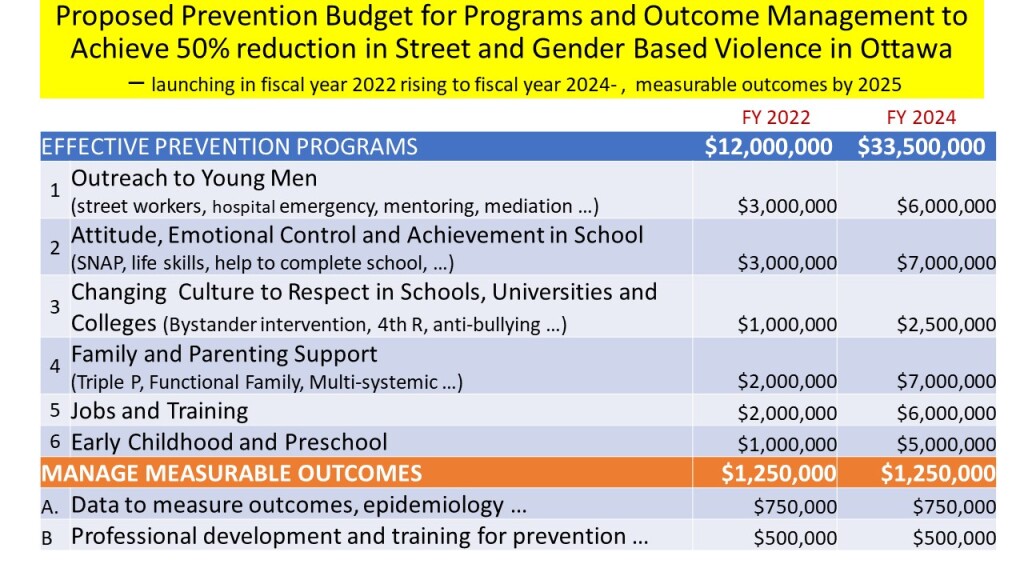Ontario requires cities to adopt a Community Safety and Well-Being Plan with measurable outcomes. So the city Finance and Economic Development Committee needs to include a prevention budget approximtely equal to 3% of police services costs and then align the Police Services Budget to it.
What is the basis for a Violence Prevention Budget ?
This is based on evidence and international best practice that will achieve the following measurable outcomes within next four years:
- 50% reduction in homicides, shootings and gender based violence, and so
- 50% fewer police interactions with Indigenous, Black and ¨equity – deserving¨ communities¨
- 50% reduction in police (and prison) costs for reacting to violent crime.
Why must city adopt a prevention budget?
The Community Safety and Policing Act, 2019, S.O. 2019, c. 1, Sched. 1 Part XVI mandates every municipality across Ontario to prepare and adopt a Community Safety and Well-being Plan by July 2021. It requires …
- Municipalities to form a committee with representation from the police service board and health/mental health, education, community/social services and children/youth services.
- The Municipality will
- use relevant data to identify and prioritize risk factors that contribute to crime, victimization and community safety and well-being;
- set out measurable outcomes that the strategies are intended to produce
- Police Service Boards will implement business plans that align with and further the goals of the Municipality’s CSWB Plan.
What is the proposed Prevention Budget
It includes Programs and Outcome Management to achieve 50% reduction in Street and Gender Based Violence in Ottawa. It would be launched in fiscal year 2022 rising to fiscal year 2024 with measurable outcomes of 50% reductions in violent crime by 2025. These dollars are for Ottawa.
Programs have been proven to be effective by:
- Scientific websites on what is proven to reduce violence such as the World Health Organization, British College of Policing, Crimesolutions.gov (US Department of Justice), Washington State Institute of Public Policy (these are the principal source of Canadian inventories);
- National commissions such as the Youth Violence Commission in the UK and National Academy reports in the US and consistent with the Council of Canadian Academies.
Achieving measurable outcomes is based on strategies consistent with:
- Guidelines to achieve outcomes (less violence) agreed by WHO, UN Office on Drugs and Crime, and UN Habitat;
- Key elements of the successful best practice violence reduction unit developed in Glasgow, which achieved a 50% reduction within 3 years and is being replicated across the UK, including the City of London;
- Managing change through raising awareness, training and data.
Benefits of using evidence, best practice (learning from success) and what we measure we treasure.
- Reduced Street and gender based violence makes citizens safer, prevents injury, trauma and death, and avoids long term chronic disease;
- Less violent crime reduces the need for:
- Policing of violent situations;
- Interactions between police and racialised and disadvantaged young men;
- Clogged courts and costs of incarceration and building additional prisons;
- Fewer homicides reverses trends, which in Ottawa are currently:
- Increasing with more guns
- Higher than cities east of Ottawa, including Montreal
- It tackles intimate partner and sexual violence before it happpens, eliminates the spike from COVID restrictions and reduce risk factor for children who witness violence in the home;
- It makes Ottawa a leader in Ontario and is one more step for the city to achieve the UN Sustainable Development Goals (SDG16.1-2, 5.2) by 2030.
This prevention Budget focuses on the most effective and cost effective way to reduce violent crime (based on evidence).
The Ontario Guide to CSWB identifies four strategies of stopping, or responding to, crime.
Social Development, such as poverty reduction, housing, schools, mental health and so on, will reduce crime over time and is expensive. It is important and also justified for other reasons.
This prevention budget ítem focuses on those persons, families and neighborhoods most at risk and so will reduce violence in effective and cost effective ways within a relatively short time period by investing in futures of people;
Risk intervention such as diversion from arrest to proven services can contribute to prevention but services must be available.
The main lesson on emergency response is that you cannot arrest your way out of violent crime. This is best illustrated from the US, where over-policing and hyper incarceration concentrated in neighborhoods of racialised poverty allows homicide rates normally several times higher than in Canada (Chicago is ten times higher than Toronto). Further unlike Canada or UK, the US urban homcide rates spiked by 30 to 50% during COVID. It is not just supply of handguns!
For more information on the dividends, both financial and human, from investing in prevention as well as sources used for evidence of effective violence prevention and essentials for successful implementation go to Waller, Irvin 2019, Science and Secrets of Ending Violent Crime.



